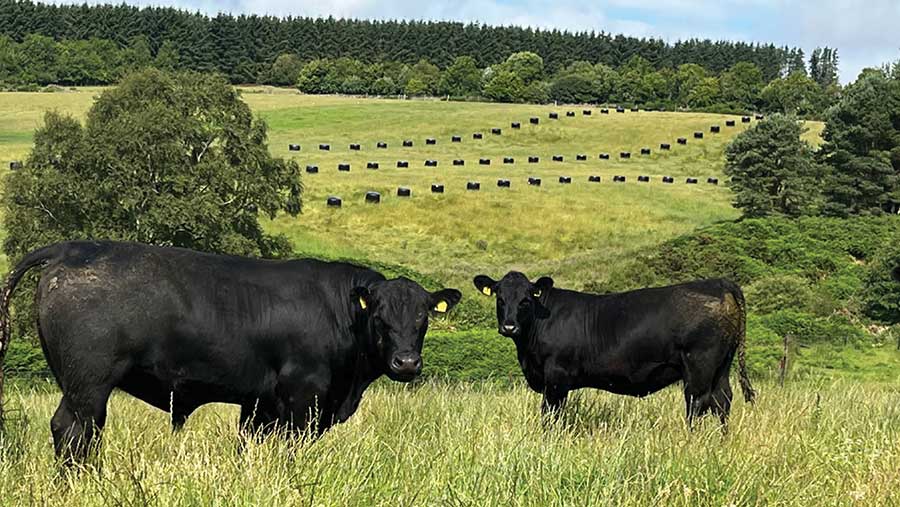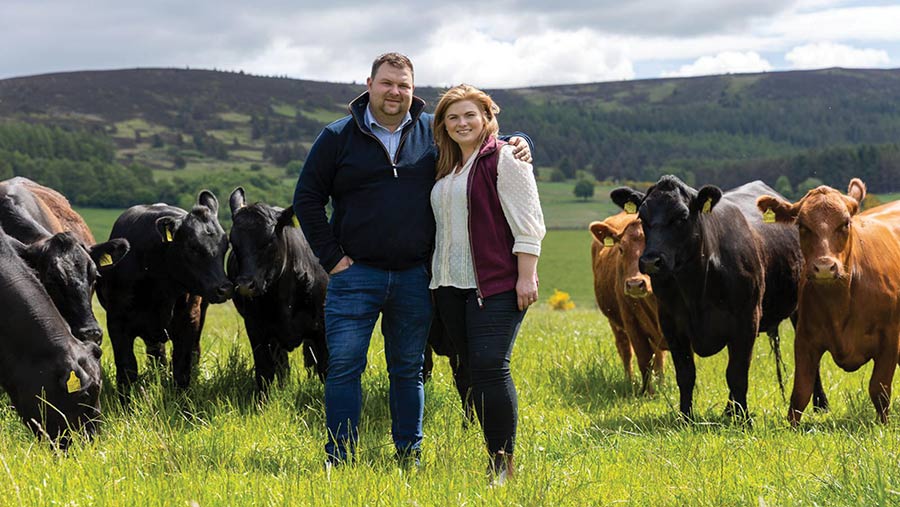How cow leasing helped grow suckler business
 © Duncan Morrison
© Duncan Morrison A part-time Aberdeenshire beef and sheep producer has become a full-time farmer by using a cow leasing arrangement to help build a suckler herd.
Describing himself as a “fourth-generation farmer with a first-generation business”, Duncan Morrison has built a 250-cow herd near Torphins, Aberdeenshire, since being made redundant from his farm management job in 2016.
He told Farmers Weekly he got the leasing idea from the “Working Cows” podcast by Clay Conry in South Dakota.
See also: Video: New entrants harness hills with £106 a cow winter feed cost
Starting out
Faced with no job, no obvious opportunities at the family farm, and very little cash behind him, Duncan’s story, which he told to the British Cattle Breeders Conference in Telford last week (22-24 January) goes as follows:
- 2016 After redundancy, he bought 50 Angus cattle (49 heifers and one bull) and got a tenancy on the 108ha (266-acre) Meikle Maldron, which became home.
- 2017 Farmed part-time and improved the grazing infrastructure of the farm alongside running a fencing contracting business.
- 2020 Approached by mixed farmer Kevin Gilbert, who had previously employed Duncan part-time as a student for three years. Kevin was restructuring his farm business and looking for someone to take responsibility for the beef enterprise. Duncan bought 50 cows, leased another 120 and rented 96ha (237 acres) from Kevin at Womble Hill.
- 2024 Duncan owns most of his 250 cows, but still rents 50 from Kevin. He also grazes his family’s 45ha (110-acre) farm, Upper Ingliston.

Duncan Morrison and his wife, Claire © Melissa Irvine
Drawing up a lease
Duncan Morrison used the professional services of independent consultant Robert Gilchrist – who is now chief executive of the Aberdeen Angus Cattle Society – to help him draw up a lease agreement for his former employer Kevin Gilbert’s cows.
Robert says the model is effectively a lease-purchase agreement in which the owning farmer gets a return on their investment (the cows).
The agreement was devised accordingly:
- Profit expectations Robert helped Duncan and Kevin budget for an expected productive output of the herd, cost base and net margins. This included a subsidy income of roughly £100 a calf from the Scottish Suckler Beef Support Scheme.
- Cost allocation Some costs were split between them, some were solely for Kevin, others only for Duncan.
- Rental fee A rent was agreed that saw Kevin receive 10.4% of the cow’s value (£1,200 as a cull at the time).
- In action Duncan pays a fee to hire a cow. Kevin remains the owner and gets the cull cow value at the end. Duncan provides the labour to keep the cow and is rewarded with ownership of all calves produced by leased cows, which can be grown and fattened or retained for breeding to build his owned portion of
the herd.
Advantages
- Lower-risk model – less capital outlay to start farming
- Controls biosecurity risk – one closed herd
- Cows came from a system Duncan understood, helping to set budgets
- Duncan employs a former member of Kevin’s staff, and gets the benefit of his knowledge and experience
- For Kevin, a steady source of income eases tax liability over seven or eight years. This is particularly pertinent for businesses not valued on a herd basis
Challenges
- Duncan had a cashflow challenge because the enterprise’s heifer development costs are not offset by the cull price
- Because Duncan wants to maintain herd size, he can sell fewer heifers, which again affects cashflow
Considerations
- A strong level of trust between lesser and lessee is essential. This was gained when Duncan worked on Kevin’s farm as a 19-year-old, and both parties have their expectations aligned
- As the owner, Kevin wanted to see Duncan succeed and make a margin from his work
- A professional to broker the agreement may be worthwhile. Duncan and Kevin signed a written agreement
Source: Robert Gilchrist and Duncan Morrison
Working cows
For the system to work in terms of labour and profit, the cows had to be low-input. Duncan put into practice what he had learned from visiting low-input New Zealand suckler farms.
To obtain bank funding, he says he needed to be different from the rest. He set the following principles:
- lnvest in flesh, not metal, to cut fixed costs
- Streamline jobs and work efficiently
- Capture economies of scale to reduce labour demand
- Control “controllables” by relying on easy-fleshing cows and forage
- Invest time in capturing and interpreting fertility, health and growth data
- Constantly pursue improvements, but appreciate everything has a trade-off.
Morrison Livestock facts
- 250 spring-calving suckler cows
- Land split between contract farmed, owned and rented
- 263ha comprising rougher hill, permanent pasture and good in-bye ground
- Finishing steers, bulls and heifers
- Pedigree sales of Angus and Stabiliser seed stock
- Small flock of Lleyn ewes
Duncan Morrison’s suckler system
- All cows and heifers calve outside in one mob from mid-April
- 160 cows to one labour unit
- Hay/silage supplement spring grass and are fed in the evening to minimise night-time calvings
- 125-day winter on bale grazing and deferred grass. Cost is 72p a cow a day (includes rent for winter grazing, silage contractor cost, rent for silage land, set-up costs and daily labour)
- Two-cycle bulling, with 77.5% conceived in first cycle
